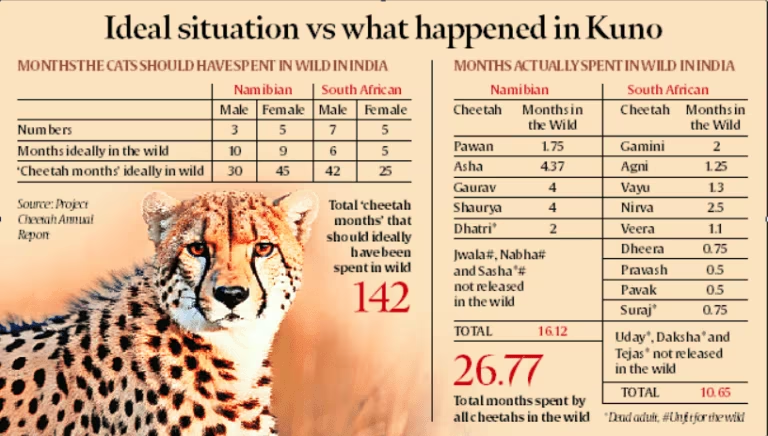Biodiversity & Environment
One Year of Project Cheetah
- 11 Nov 2023
- 6 min read
For Prelims: Cheetah Reintroduction Plan, Kuno-Palpur National Park (KNP), CITES
For Mains: Challenges Associated with the Translocation of Cheetah in India, Importance of Biodiversity, Genetic, Species, Ecosystem.
Why in News?
Project Cheetah, India's ambitious attempt to introduce African cheetahs in the wild in the country, has been completed a year after its launch in September 2022.
- The project has claimed to have achieved short-term success on four counts: “50% survival of introduced cheetahs from South Africa and Namibia, the establishment of home ranges, the birth of cubs in Kuno”, and revenue generation for local communities.
What Are the Comprehensive Outcomes of Project Cheetah's First Year?
- Survival in the Wild:
- According to the Cheetah reintroduction project, Cheetahs, meant for a total of 142 months in the wild, spent less than 27 months combined.
- The project faced a setback with a 40% loss in the functional adult population, resulting in the death of six out of 20 cheetahs, including Dhatri, Sasha, Suraj, Uday, Daksha, and Tejas.
- Additionally, four cubs were born in India, of which three died, and the fourth is being raised in captivity.
- Home Range Establishment:
- The goal was for cheetahs to establish home ranges in Kuno.
- Only three cheetahs, namely Namibian imports Asha, Gaurav, and Shaurya, spent more than three months continuously in the wild. However, they have been confined to bomas(enclosures) since July 2023.
- There are doubts about the successful establishment of "home ranges" in Kuno.
- The goal was for cheetahs to establish home ranges in Kuno.
- Reproduction Success:
- The Action Plan aimed at successful cheetah reproduction in the wild.
- Siyaya aka Jwala, a Namibian female, gave birth to four cubs in Kuno. However, she was captive-raised and considered unfit for the wild. Her cubs were born inside a hunting boma.
- The reproduction goal faces challenges and compromises, raising questions about the project's long-term success.
- The Action Plan aimed at successful cheetah reproduction in the wild.
- Contribution to Local Livelihood:
- Project Cheetah positively contributed by generating jobs, and contracts, and appreciating land prices around Kuno.
- No reported human-cheetah conflicts in the area, indicating a harmonious coexistence between the introduced cheetahs and local communities.
- Project Cheetah positively contributed by generating jobs, and contracts, and appreciating land prices around Kuno.
What Challenges Does Project Cheetah Face?
- Integrity Challenges:
- Three Namibian cheetahs, Sasha (the project's first casualty), Jwala, and Savannah alias Nabha, were captive-raised as "research subjects," compromising the integrity of the project.
- Shift in Stance:
- India's decision to abstain from the Convention on International Trade in Endangered Species of Wild Fauna and Flora (CITES) vote against trade in elephant ivory weeks after importing cheetahs raised ethical concerns about the project's commitments.
- Paradigm Shift Ahead:
- Kuno's inability to support a genetically self-sustaining population necessitates a paradigm shift towards a meta-population approach.
- A meta-population approach involves managing distinct populations of a species in fragmented habitats, acknowledging their interdependence for long-term viability and genetic diversity.
- Unlike leopards, cheetahs cannot travel long distances between scattered populations on their own.
- Borrowing from the South African model of periodic translocation for genetic viability is proposed, but concerns arise about the impact on forest connectivity for natural wildlife dispersal.
- Kuno's inability to support a genetically self-sustaining population necessitates a paradigm shift towards a meta-population approach.
- Kuno's Carrying Capacity:
- The Cheetah Action Plan estimated a high probability of long-term persistence with populations exceeding 50 individuals.
- A feasibility report in 2010 estimated 347 sq km of Kuno could sustain 27 cheetahs, while the larger 3,000 sq km landscape could hold 70-100 animals.
- Revised assessments in 2020 indicated Kuno's cheetal density at 38 per sq km, supporting 21 cheetahs, challenging the feasibility of a single population of 50 cheetahs.
- The Cheetah Action Plan estimated a high probability of long-term persistence with populations exceeding 50 individuals.
- The project's only option now is a meta-population scattered over central and western India, posing challenges compared to the South African model of assisted dispersal.
What is the Cheetah Reintroduction Project?
- The Cheetah Reintroduction Project in India formally commenced on September 17, 2022, to restore the population of cheetahs, which were declared extinct in the country in 1952.
- The project involves the translocation of cheetahs from South Africa and Namibia to Kuno National Park in Madhya Pradesh.
- The project is implemented by the National Tiger Conservation Authority (NTCA) in collaboration with the Madhya Pradesh Forest Department, Wildlife Institute of India (WII), and cheetah experts from Namibia and South Africa.
Note:
- Cheetahs, the fastest land animals, are considered "crepuscular" hunters, meaning they hunt at sunrise and sunset.
- Cheetah females have a gestation period of 92-95 days; and will give birth to a litter of approximately three or five cubs.
UPSC Civil Services Examination Previous Year Question (PYQ)
Prelims
Q. Consider the following: (2012)
- Black-necked crane
- Cheetah
- Flying squirrel
- Snow leopard
Which of the above are naturally found in India?
(a) 1, 2 and 3 only
(b) 1, 3 and 4 only
(c) 2 and 4 only
(d) 1, 2, 3 and 4
Ans: (b)








